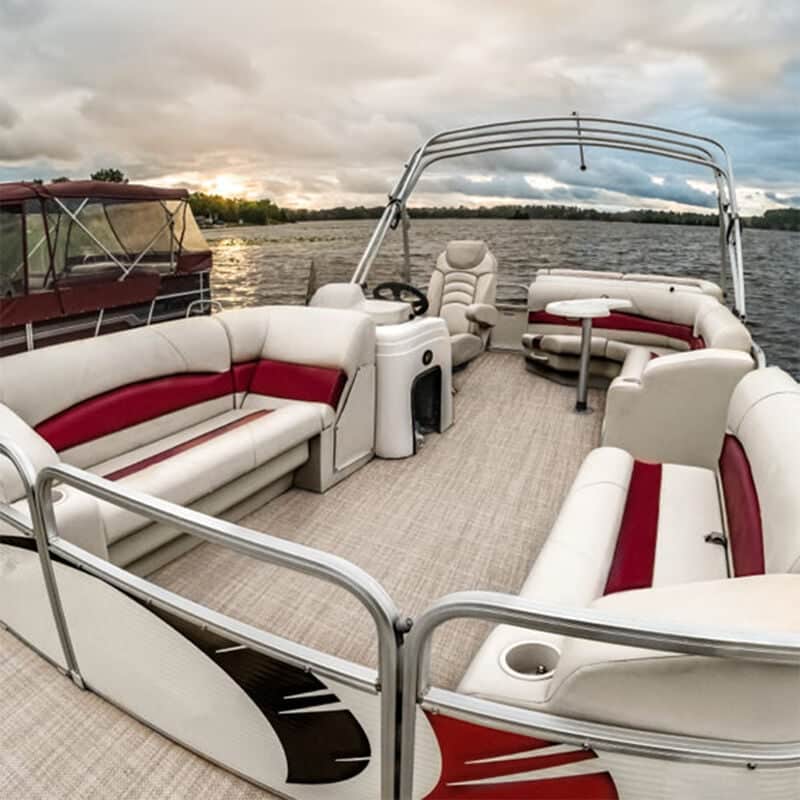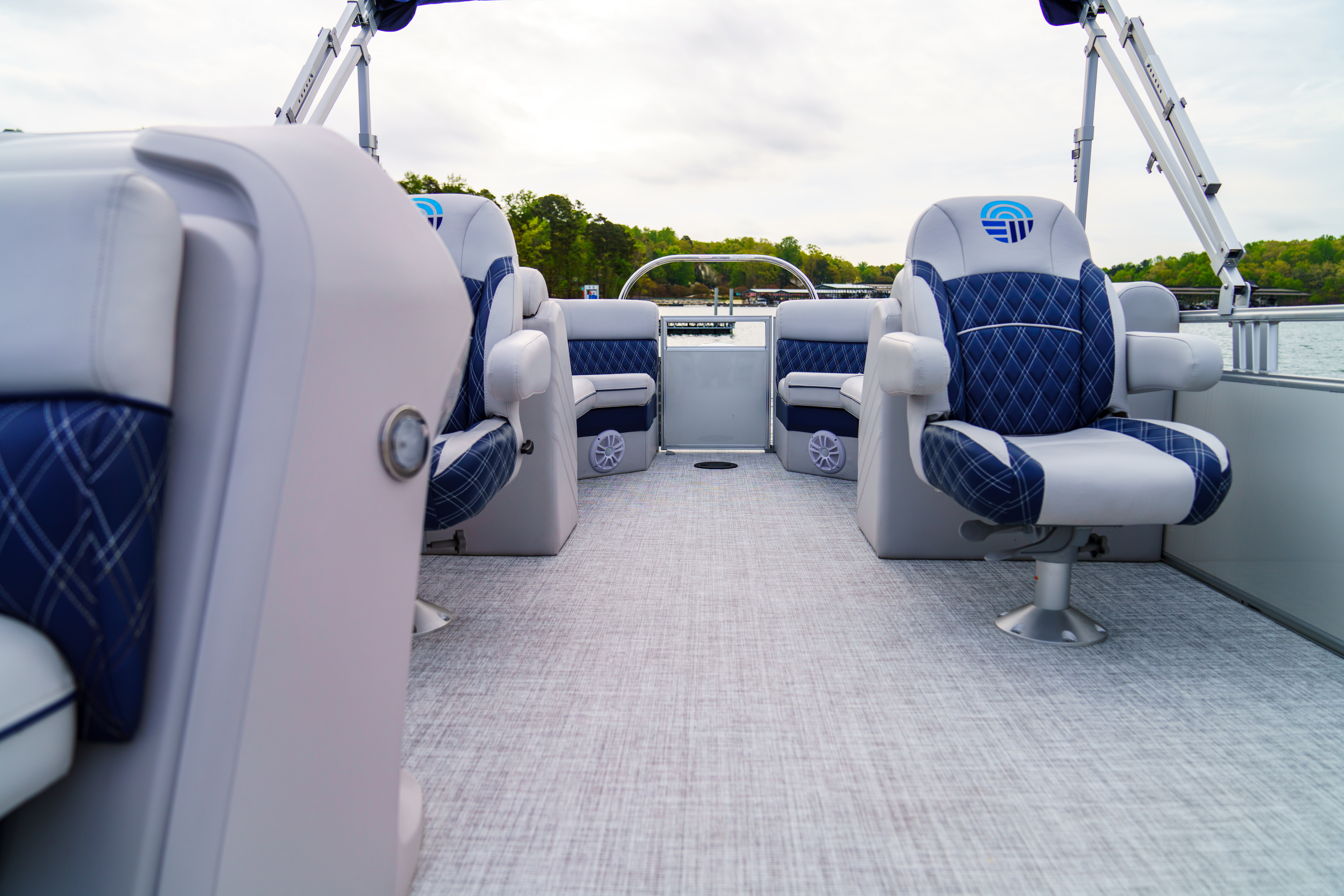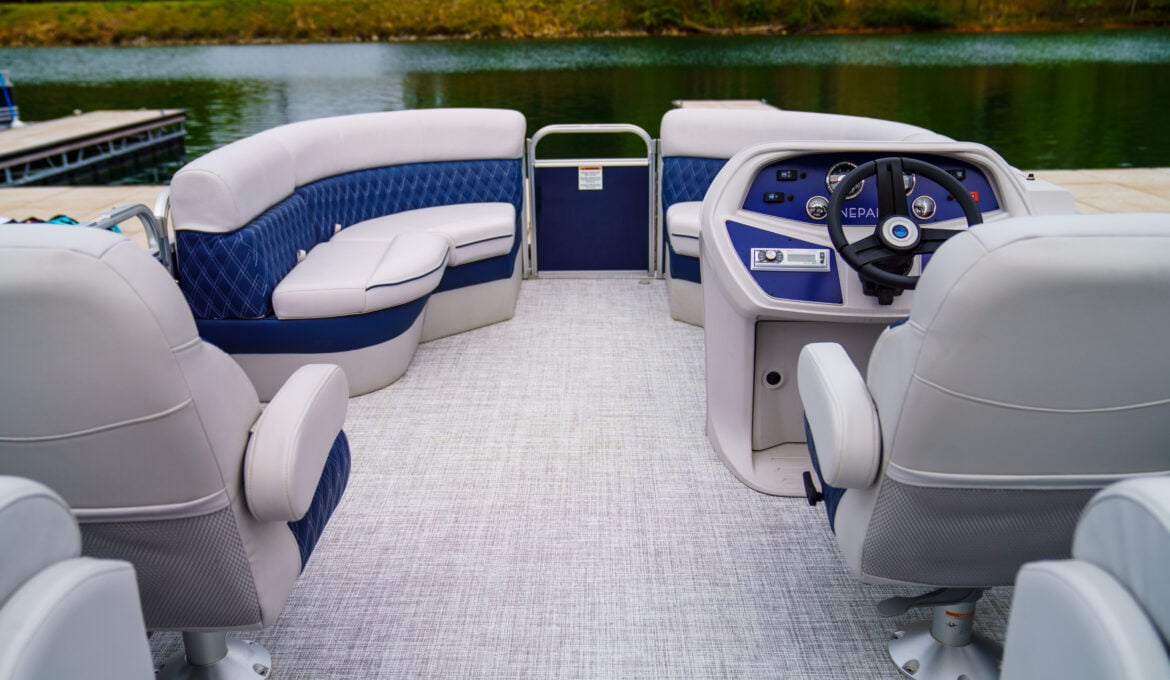The flooring in your boat takes a lot of abuse. This abuse comes in the form of harsh elements like constant UV exposure, a frequent build-up of dirt and grime, and general wear and tear from use. There are many reasons to replace the flooring in your boat; whether you want to switch types, change up the look with a new color, or simply replace worn down, faded, or stained flooring with new, we’re here to help.
This article will discuss everything you need to know about choosing marine carpet or vinyl flooring for your boat.
Types of Boat Flooring

The most common types of boat flooring are PVC, foam, wood, vinyl, and carpet. Each has pros and cons, but regarding durability, ease of installation, and affordability, marine carpet and vinyl flooring are the best options. Let’s review which would be a good fit for you.
Marine Carpet
Carpet is the most affordable flooring choice. It is popular for many reasons, with comfort and cost being the most prominent factors. It’s soft under your feet after a full day of boating, and it won’t break your wallet when it’s time for replacement.
However, carpet has some downsides. Stains show easily and are tough to remove. It will also fade after continued UV exposure. Like most marine flooring options, it gets hot after a long period of direct sunlight.
| Pros | Cons |
| Cost Effective | Shows Stains |
| Comfortable | Prone to Fading |
| Hot to Touch |
Marine Carpet Materials
Polypropylene and polyester are the two most popular materials for constructing marine carpet. Polypropylene is slightly more popular, but both are good options.
Polypropylene is very durable and has built-in UV protection. This carpet will stay looking new longer.
Polyester is mildew-resistant, so it stays clean longer. It is also softer than polypropylene, making it more comfortable.
Can I Use House Carpet In My Boat?
Marine carpet is very different from the carpet in your home. For starters, the backing is made of different materials. Marine carpet allows water to pass through without trapping it, whereas the carpet in your home will trap water, leading to mold and mildew. Marine carpet also has UV inhibitors that resist the strong UV rays from the sun. Although some household carpets are synthetic, they still won’t be able to stand up to harsh conditions aboard a boat.
It is tempting to use standard household carpet because it’s cheaper, but it won’t last.
Vinyl Flooring

Vinyl flooring has many benefits. It’s durable and won’t fade or crack even in constant, direct sun exposure. Due to its smooth surface, it’s easy to clean and maintain. A simple hose-off and occasional scrub will keep it looking new.
Although vinyl flooring is typically more expensive than marine carpet, it’s still more affordable than other boat flooring options. The main downside of vinyl flooring is that it can be slippery when wet, so you’ll want to take careful consideration if you get a lot of spray inside the boat.
| Pros | Cons |
| Durable | Slippery When Wet |
| Easy to Clean | Hot to Touch |
| Affordable |
Factors To Consider When Choosing Between Marine Carpet and Vinyl Flooring

There isn’t one marine flooring option that works best for everyone; it comes down to several factors. Let’s take a look at some of these below.
Boat Type: You may value an easy-to-clean flooring option if you have a fishing boat. In this case, vinyl flooring would be a better option than carpet because cleaning and keeping clean are much more manageable. However, if you and your family take a pontoon boat out for long days on the lake, you may prefer marine carpet due to the increased comfort and better traction on deck.
Location: The area where you use and store your boat is a significant factor in choosing a flooring option. For example, if you frequent boating in southern states with a lot of sun and store your boat outside while not in use, you might value vinyl flooring over carpet since it won’t fade or crack.
Aesthetics: Although subjective, some prefer the look of vinyl flooring more than carpet. They each have many patterns and colors to choose from, although patterns are typically easier to produce on vinyl flooring than on carpet. If you want a teak floor look but can’t afford to outfit your floor using real teak, a teak vinyl pattern is a great substitute.
Budget: Marine carpet and vinyl flooring are both cost-effective options. Although the price of marine carpet can exceed that of vinyl flooring, depending on the material, it’s generally considered more affordable.
How Much Flooring Do I Need for My Boat?

The amount of flooring you’ll need depends on several factors. The biggest factor is the size of your boat, both the length and width. Measure the widest and longest points, then order enough material to cover this and a bit more. If this is your first time, you’ll need to leave yourself room for error in case you make a bad cut. Remember, you can always remove more material but you can’t add it back.
Pontoon boats have a pretty flat floor, so you can accurately measure how much flooring you need. On the other hand, a bass boat’s floor is not very flat, and you’ll need extra material to wrap over and around the lids. So it’s a good idea to order about 20% more than what you measure for.
How To Install Flooring on Your Boat in 5 Easy Steps
The process of installing marine carpet or vinyl flooring on your boat is pretty similar. No matter your choice, you’ll need to gather some tools. Let’s take a look at some common tools you may need below.
- Screwdriver
- Sockets/Wrenches
- Sander
- Scraper
- Tape Measure
- Cutting Tool
- Straight Edge
- Staple Gun
- Paint Roller or Brush
- Adhesive Remover (Optional)
Step 1: Prep Boat
Let your boat sit in the sun for a few hours to help loosen the adhesive. Using a socket and wrench or screwdriver, remove the seats, console, or other components that may interfere with removing the old flooring.
Step 2: Removing Old Flooring
Begin removing old flooring by cutting around the edges and pulling up. Continue the process until all flooring material is removed. Try to cut the old flooring off in large sections to use as a template for the new flooring.
Step 3: Prep Floor
Once all flooring material is gone, remove the old adhesive. This can be done by scraping or sanding. Depending on the construction of your boat floor, you may also be able to use an adhesive remover. Make sure the surface is smooth, level, and clean before proceeding.
Step 4: New Flooring
Using the manufacturer’s recommended adhesive, use a brush or roller to spread it on the floor. Pay close attention to ambient temperature and working time. Work in small sections rather than applying adhesive to the entire floor first. Measure areas before cutting and press down firmly to ensure good adhesion and removal of excess air. You may also need to use fasteners such as staples to keep the flooring in place, especially around the edges.
Step 5: Clean and Let Dry
Clean up leftover materials from the deck, such as loose scraps. Let the adhesive fully cure and dry before use. Follow all flooring manufacturer’s dry times, cleaning, and use guidelines.
Here are some other articles you may find helpful:
- The Complete Maintenance Guide for Your Boat Trailer
- Everything You Need to Know About Towing a Boat Trailer
- What are Mooring Whips and How Do You Use Them
Replacing your flooring can be exciting. It’s a lot of hard work, but doing it yourself can save you money. Hopefully, you know what you want to use for your next project and have the confidence to do it yourself.
Let us know your favorite marine flooring in the comments below!





[…] you have the deck clear, inspect the flooring. If the carpet or vinyl shows signs of wear, replace it before installing new seats. You’ll also want to inspect the flooring underneath the […]